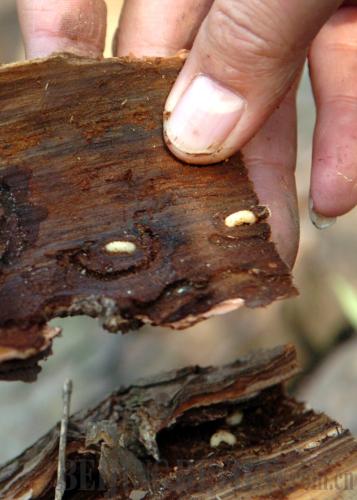|
 |
|
SILENT KILLERS: Larva of monochamus alternatus hidden under pine bark, a vector of the pinewood nematode that kills the tree (XINHUA) |
Some of these species reproduce and flourish in their new environment. This success is due largely to the absence of natural predators and parasites, and this may allow alien species to out-compete native species, usurping their niche in the habitat. Introduced species that have negative effects on native species, or cause economic or environmental problems are generally referred to as "invasive" species.
Pomacea canaliculata, the South American freshwater apple snail, was introduced in China as a food in the early 1980s and snail farms were established around the country. However, its taste was not widely accepted by Chinese and farmers started to dump the snails in the wild. The random disposal of the snail, which lays up to 1,200 eggs per month, led to extensive damage to rice fields. The snail lays eggs above the water's surface, protecting them from small fish and water bugs. To reduce the damage, Chinese farmers are forced to use pesticide to kill the invasive snail, polluting the environment and wiping out many benign organisms.
Introduction of alien species may also lead to genetic pollution. An example is Taiwan island thrush, whose genetic purity is endangered, as the rare thrush interbreeds with its counterparts from the Chinese mainland.
Chen warned that the threat to China's ecosystems posed by the introduction of alien species, such as bullfrog, red-eared slider and crayfish, is yet to be fully understood. For example, bullfrogs, widely raised in China as food, are also swallowing up different species of smaller indigenous frogs.
China also has many flora examples of ecological disasters caused by alien species. Common cordgrass was first introduced to China from Britain in the 1960s for coastal erosion control purposes. Its dense root systems bind coastal mud and the stems increase silt deposition, thereby assisting in land reclamation from the sea.
The grass was widely planted at coastal sites throughout China in the 1980s. Its invasive nature has surfaced in recent years. As vegetative spread by rhizomes is rapid, the grass colonized large areas of tidal mudflats. Using the oxygen in the seawater when submerged during high tides, the grass has severely smothered local aquatic ecosystems, and has wiped out indigenous clams, shrimp and crabs in the Yellow River Delta less than a decade after it was introduced to this area. China now has the largest total area of common cordgrass in the world, which appeared on the country's first list of invasive alien species in 2005.
Long-lasting battle
According to Nanfang Daily published in Guangzhou, introduced species posing the greatest threat to agriculture such as the pine wood nematode, water hyacinth, climbing hempweed, vegetable leafminer and rice water weevil, caused direct economic losses totaling more than 50 billion yuan ($7.83 billion) every year in China. The government invests around 1.48 billion yuan ($232 million) annually on preventing new invasive species from entering and spreading.
China's Ministry of Agriculture established the Center of Management of Invasive Alien Species in 2003. Chen said that this organization has not been able to check the further spread of alien species into China. "An alien species finds its way into China through various pathways, making the preventive work highly difficult. It requires coordination of different government departments," Chen told Nanfang Daily.
The coconut leaf beetle is a pest that feeds on the young leaves of coconut palms. The insect, which is considered native to Indonesia and Papua New Guinea, has recently developed into a serious threat to the coconut industry in south China's Hainan Province. Resorting to biological control agents, the local government has invested 1.7 million yuan ($266,295) to purchase 275 million parasitic wasps in 2012. Another 125 million parasitic wasps are planned to be released into the wild by the end of this year.
Although the use of parasitic wasps has proven effective in reducing the beetles, the wasps could die or stop reproducing after a prolonged period of rain or low temperatures. This explains the surge of beetles each January, the coldest month in Hainan.
"A lot of resources need to be pooled into the research and control of invasive species in China," Chen said.
Email us at: lili@bjreview.com | 